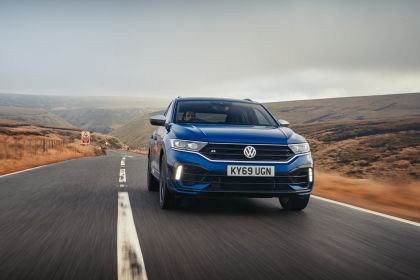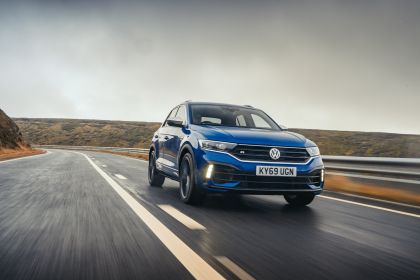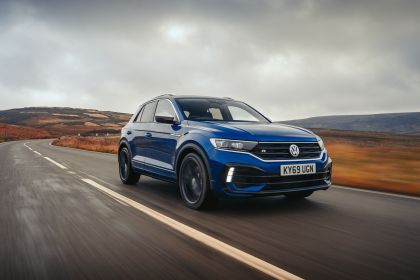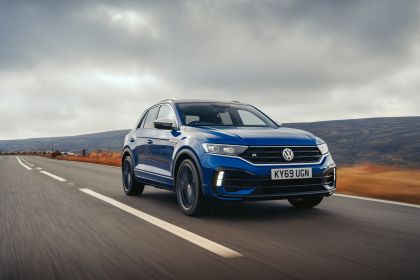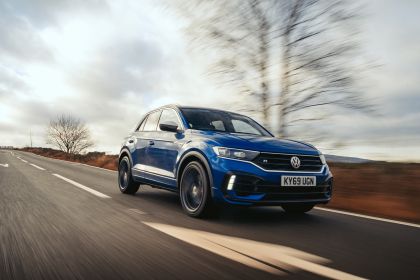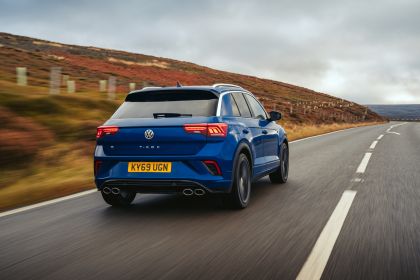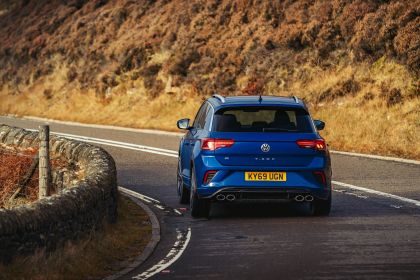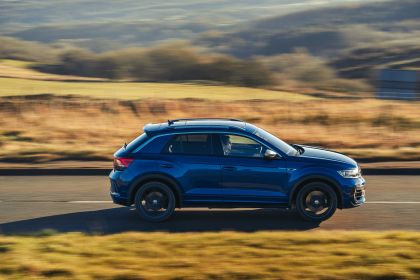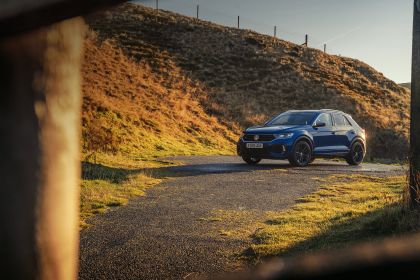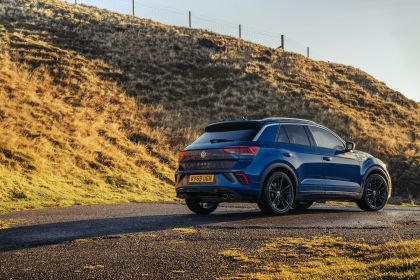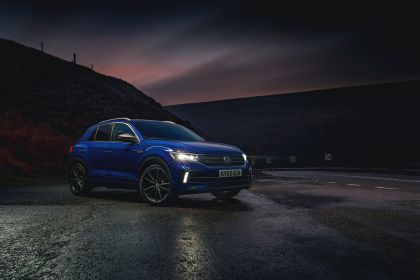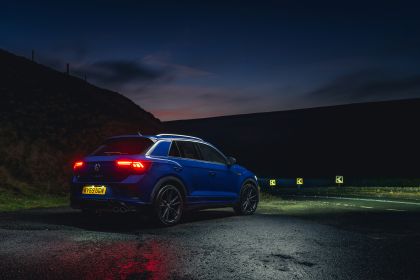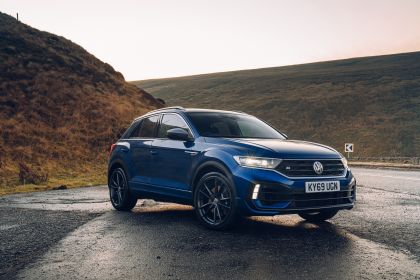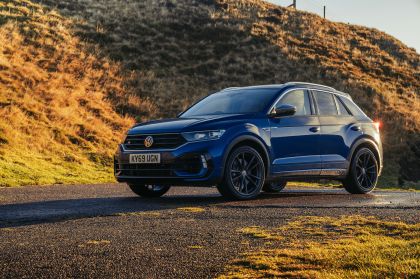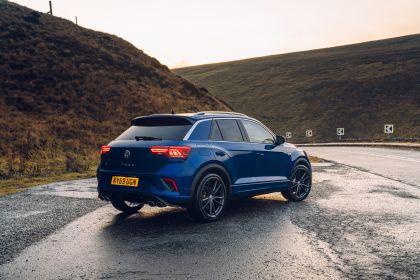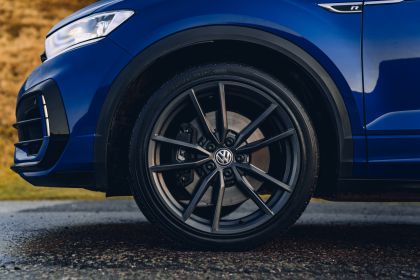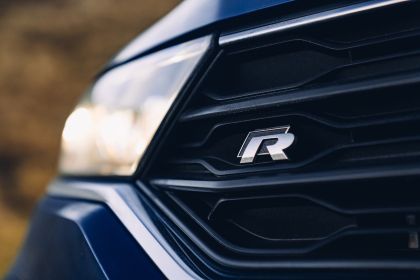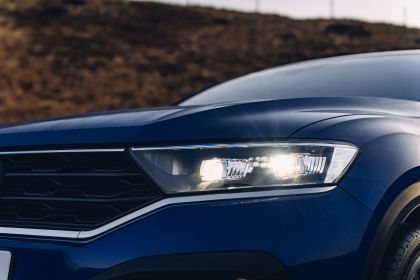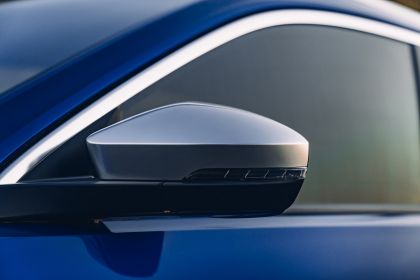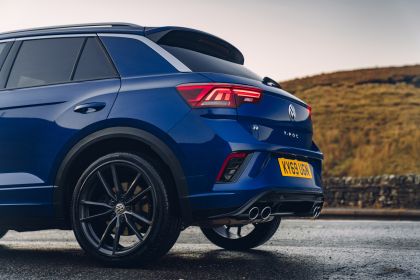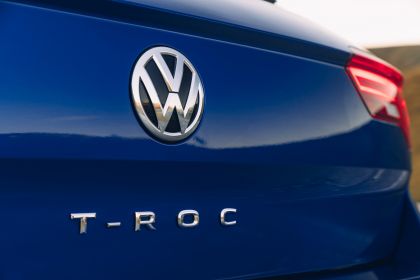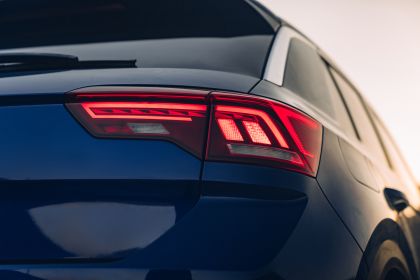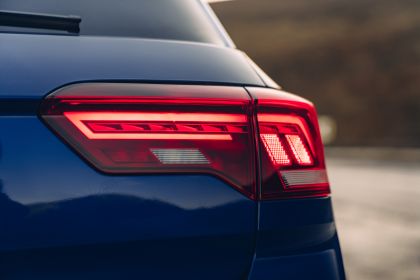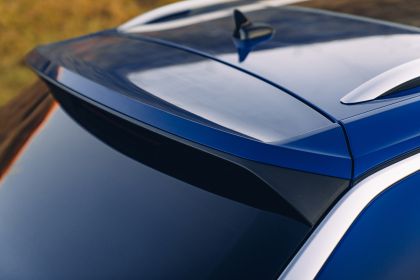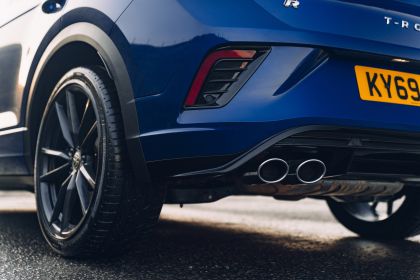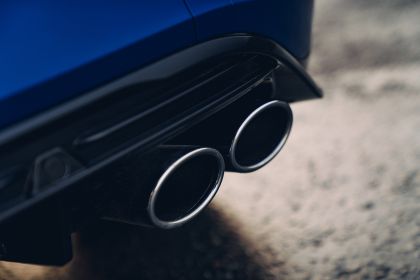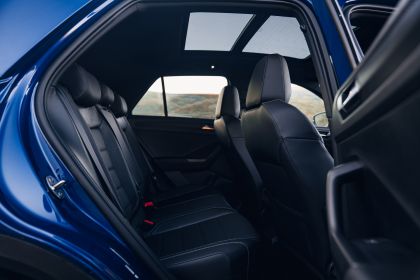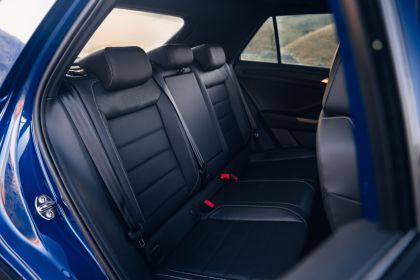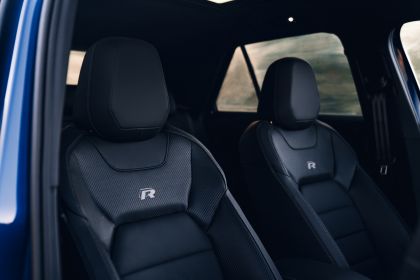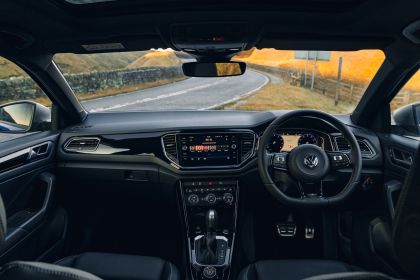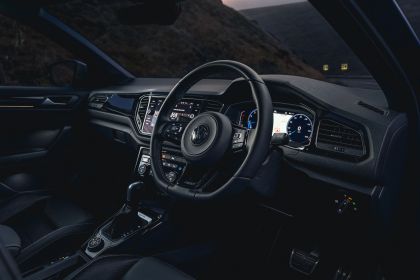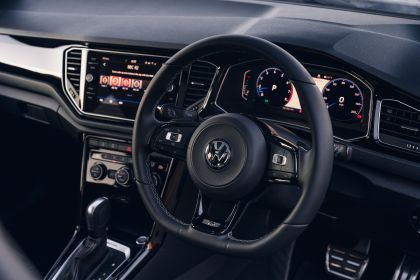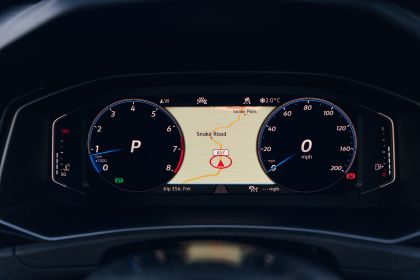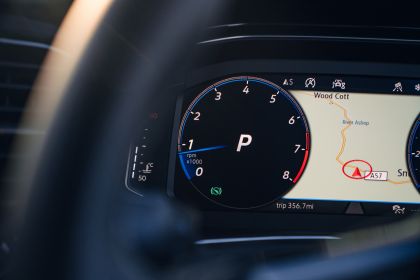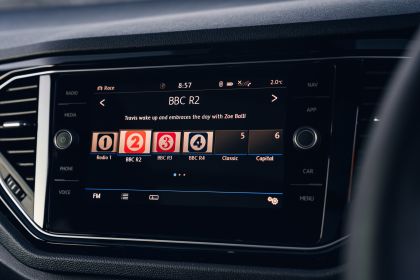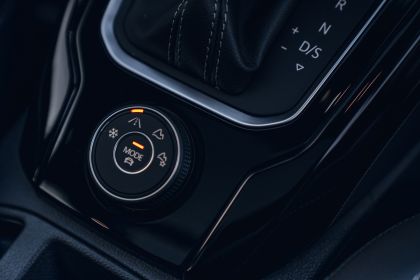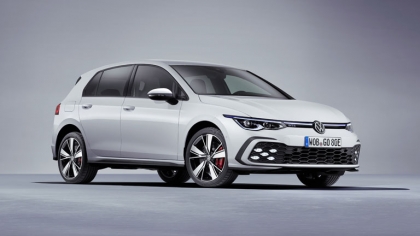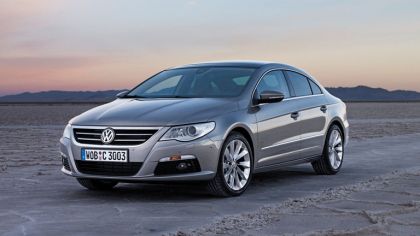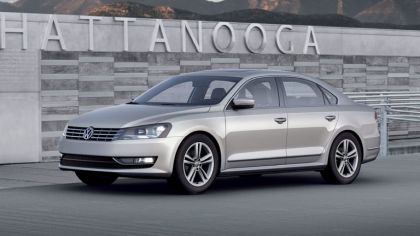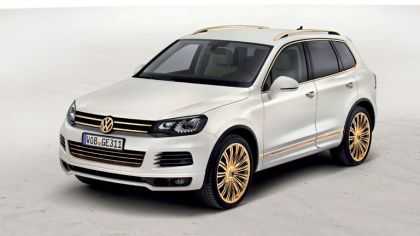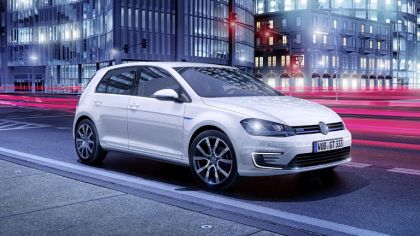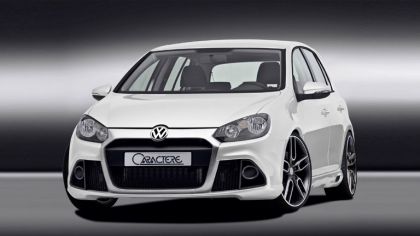The T-Roc was introduced to the Volkswagen range in October 2017. It joined a booming SUV segment across the industry, and a growing SUV family from Volkswagen. As the first compact SUV from Volkswagen, the T-Roc majors on style, practicality and personalisation. It features a coupé-like roof line as part of its bold design, an expansive colour palette with stand-out personalisation options and design packs, with the same blend of quality, space and user-friendliness that Volkswagen is renowned for.
Based on the MQB platform, the T-Roc measures 4,234 mm long (252 mm shorter than the Tiguan), and has a 2,590 mm wheelbase. The SUV’s width is 1,819 mm (excluding door mirrors), and its height is 1,573 mm. For comparison, the current Golf (Mk 7) measures 4,255 mm long, 1,799 mm wide (excluding mirrors), 1,452 mm high, and has a wheelbase of 2,637 mm. The T-Roc sits in the compact end of the Volkswagen SUV range, above the T-Cross but beneath the Tiguan, Tiguan Allspace and Touareg.
The MQB platform also bestows upon the T-Roc hatchback-like composure and handling in its list of virtues. The performance-focussed T-Roc R joined the line-up in late 2019, and a Cabriolet version adding to the model’s feel-good appeal will arrive in spring 2020.
Contents
Fast facts
Technical highlights
Trim levels, equipment and options
Engines, transmissions and running gear
Design (interior and exterior)
Market information
Servicing and warranty
Technical data
Dimensions
The T-Roc R
Fast facts
Engine, transmission and running gear
Design
Market information
Technical data
Fast facts
- T-Roc was first previewed as the T-Roc Concept unveiled at the Geneva Motor Show in 2014, while the T-Roc Cabriolet was inspired by the T-Cross Breeze Concept, revealed at the 2016 Geneva Motor Show
- The T-Roc went on sale in October 2017 as the third SUV in the Volkswagen range
- The model followed on from the Touareg and Tiguan, sitting beneath the Tiguan as the brand’s then most compact SUV. It has since been joined by the Tiguan Allspace (sitting above the Tiguan), and the T-Cross (the smallest Volkswagen SUV) to complete a five-strong SUV line-up
- The sporty T-Roc R joined the range in 2019 and the T-Roc Cabriolet will arrive in Spring 2020 (there is a specific T-Roc R section at the end of this press pack)
- In the UK four petrols and two diesels make-up the full engine range
- The TSI petrol engines range in power from 115 to 300 PS, while the diesel engines range from 115 to 150 PS
- All engines are Euro VI compliant and the petrol line-up includes the use of the acclaimed 1.5-litre TSI EVO petrol (150 PS) with ACT Active Cylinder Technology to enable cylinder deactivation
- Gearbox options are a 6-speed manual or 7-speed DSG unit, with the DSG option available on 150 PS output engines and above. The two most powerful petrol engines (190 and 300 PS) have DSG and 4MOTION all-wheel drive as standard
- Compact outside, capacious inside: this full five-seat car has one of the largest luggage compartments in its class with up to 445 litres when the rear seats are in place
- The T-Roc is based on Volkswagen’s impressively flexible modular transverse matrix (MQB), a platform it shares with the Polo, T-Cross, Golf, Touran, Tiguan, Tiguan Allspace, Passat, and Arteon
- The most potent version is the T-Roc R, equipped with a 300 PS 2.0-litre TSI powerplant, 4MOTION all-wheel drive, and a 7-speed DSG gearbox as standard
- The T-Roc offers premium segment technology such as the use of the second generation Active Info Display, as well high-end infotainment and state-of-the-art assistance systems
- The car opened for order in the UK in October 2017, with first customer deliveries taking place in January 2018. Since then, the T-Roc has become one of Europe’s most popular SUVs
- Worldwide, Volkswagen estimates that over the next ten years the annual global sales volume of the small SUV sector will grow from around 6.4 million units today to around 10.6 million, with 50% of Volkswagen sales anticipated to be SUVs by 2025
- The T-Roc makes a significant contribution to the sales performance of Volkswagen UK, quickly joining Golf (57,014 sales in 2019) and Polo (37,476 sales in 2019) among the top-sellers in the Volkswagen range, with 21,808 sales across last year
- Around six-in-ten T-Roc models sold in the UK are petrol-powered, and 42% of T-Roc sales went to private buyers
- The best-selling T-Roc in the UK is the 1.0-litre TSI 115 PS SE 6-speed manual
- Standard-fit items across the range include 2Zone electronic climate control, Composition Media infotainment system with eight-inch colour touch-screen, Bluetooth telephone and audio connection, DAB radio reception, USB connectivity and charging, and 6 x 20W speakers, minimum 16-inch alloy wheels and extensive passive and active safety equipment
- High-end options available for the T-Roc (depending on trim level) include an electrically operated tailgate, electrically operated sliding/tilting panoramic sunroof, ‘Vienna’ leather upholstery, wireless smartphone charging (compatible handsets) and a 400-watt six-speaker audio system by BeatsAudio
- Competitor cars include the Nissan Qashqai, Renault Kadjar, Toyota CH-R, MINI Countryman and Audi Q2
- The Volkswagen T-Roc is built at the brand’s Sebútal plant near Lisbon, Portugal
Technical and safety highlights
The T-Roc majors on personalisation – it can be adapted to a driver’s personal preference via a large range of convenience systems, including features such as dynamic chassis control (DCC). The system’s electrically adjustable dampers enable the T-Roc running gear tuning to be very sporty, or more pliant and comfortable. The car’s dynamic character and feel are also optimised by progressive steering, which was originally introduced in the Golf GTI Mk 7 (enabling better control in sporty driving conditions and yet also making manoeuvring easier).
Bristling with advanced and innovative assistance systems, the T-Roc is a clear leader in its market segment when it comes to these types of technology. Standard features on all T-Roc vehicles include: the Automatic Post-Collision Braking System; the active lane keeping system Lane Assist and the Front Assist area monitoring system with Pedestrian Monitoring and City Emergency Braking. Adaptive Cruise Control is standard from best-selling SE trim and up, while Volkswagen’s Active Info Display comes as standard on SEL cars and above.
It is simple to adapt the convenience, assistance and infotainment systems in the T-Roc to the individual driver. This is done via the personalisation function, included as standard. From the multifunction display, the driver can save individual settings for more than 100 parameters – depending on the features installed in the specific vehicle. They are activated as soon as the driver opens the T-Roc with their personal key.
Standard-fit safety equipment on the T-Roc includes a curtain airbag system, driver’s and front passenger’s airbags, front seat side impact airbags, safety optimised head restraints for the driver and front passenger, and Front Assist with city emergency braking and predictive pedestrian protection.
Below are some technology and safety equipment highlights either standard-fit or optionally available on the T-Roc:
Adaptive Cruise Control (ACC) – Uses a sensor to measure the distance to the vehicle in front, and its relative speed. Using the relevant buttons on the multifunction steering wheel, the driver sets a desired following distance and speed (between 19 mph and 130 mph in the T-Roc with a manual gearbox, and 0 to 130 mph with DSG). When following other vehicles, the driver may optionally choose to have a comparison of the target and actual gaps shown on the multifunction display. A sensor constantly monitors the zone in front of the vehicle. The driver can interrupt ACC control and accelerate more vigorously by pressing the accelerator pedal. Use of the brake pedal immediately deactivates the ACC function.
Lane Assist – The lane-keeping system Lane Assist is started from the multifunction display and is then active from a driving speed of 37 mph. A camera module in the interior mirror tracks lane markings and evaluates the vehicle’s position. If the vehicle begins to leave its lane, Lane Assist warns the driver – within its system limits and depending on the model – by means of an audible signal, vibration of the steering wheel or a corrective steering intervention. The system does not react if the turn signal was set before driving over a lane line.
Traffic Jam Assist – A system that utilises ACC and Lane Assist to enable convenient and safe stop-and-go driving in a traffic jam. In heavy traffic at driving speeds from 0 to 37 mph the system responds to other vehicles and autonomously handles steering, accelerating and braking. When traffic comes to a standstill, it also brakes the vehicle to a stop and can drive off again within a predefined time interval. In contrast to pure Adaptive Cruise Control (ACC), Traffic Jam Assist uses a camera behind the windscreen to detect lane markings. This enables the vehicle to be kept in the lane via Lane Assist.
Active Cylinder Technology (ACT) – Volkswagen’s cylinder deactivation system. Currently fitted on the 1.5 TSI EVO 150 PS engine. When travelling within certain engine and driving speed ranges, two of the four cylinders are deactivated regardless of which gear is selected – a process that is imperceptible to the driver. This optimises the engine’s operating efficiency while significantly reducing fuel consumption. The multifunction display indicates which engine mode is currently active.
Active Info Display – The T-Roc’s optional Active Info Display is the second generation of Volkswagen’s digital instrument system, and is distinguished by an 10.3-inch display, high-quality graphics (133 dpi; resolution 1,280 x 480 pixels). Using the ‘View’ button on the multifunction steering wheel, the driver can now also switch between three layouts, easily and quickly. It is possible to customise the display and, among other things, see the telephone display with contact images and call information, or full-screen navigation, or album artwork from the Media Library. Information shown constantly, such as trip mileage and outside temperature, always stay in the same positions.
App-Connect – This makes it possible to connect a smartphone to the Composition Media radio system or Discover Navigation Media navigation system. This enables users to operate selected mobile phone apps from the touchscreen. App-Connect integrates three interfaces to connect smartphones: MirrorLink™, Android Auto™ from Google and Apple CarPlay™. This means that it is compatible with all of today’s smartphones running Android 5.0 or higher and Apple iOS 8.1 or higher.
Rear Traffic Alert – Takes much of the risk out of reversing from driveways and parking spaces that are at right angles to the road. The system not only ‘recognises’ stationary or moving vehicles directly behind the T-Roc, but also vehicles approaching from the side which are barely visible to the driver. The radar-based sensor module even detects objects at distances of up to 40 metres and recognises objects moving at speeds of 3 mph or faster. If a collision is imminent, the system produces an audible warning. If the driver or other road user does not take action to avert the danger, or if there is a risk of immediate collision, the Rear Traffic Alert system automatically activates the car’s brakes. It is offered in combination with the Blind Spot Monitor.
Blind Spot Monitor – Assists the driver in changing lanes. Two radar systems at the rear of the vehicle scan zones up to approximately 50 metres rearward, as well as the blind spot next to the vehicle. Whether or not the driver is changing lanes, the Blind Spot Monitor shows all vehicles that are located in a critical zone for lane changes. Active from 19 mph, the system alerts the driver of a potential hazard by illuminating a constant light in the relevant exterior mirror. If the driver activates the turn indicator despite the warning, the LED on that side begins to flash at a higher intensity to call the driver’s attention to the hazard.
Dynamic Chassis Control (DCC) – The electrically adjustable damping system adapts automatically to this setting, as does the electromechanical power steering. DCC responds continually to changing driving situations and takes braking, steering and acceleration into account. This makes it possible to adjust the running gear to a normal, sporty or enhanced comfort mode.
Emergency Assist – Monitors driver activity such as use of the accelerator pedal, brakes and steering. It helps, within system limits, to prevent accidents and reduce the potential consequences of an accident if the driver is incapacitated for health reasons. If the driver fails to respond, the system prompts them to correct the steering by means of repeated brake jolts, and it automatically applies the brakes. In this process, ACC monitors the distance to traffic ahead, while Lane Assist ensures that the vehicle stays within its lane. Emergency Assist alerts other road users to an issue via the hazard warning lights and with gentle steering movements to sway the car within its lane and safely slows the vehicle down – all the way to a standstill.
4MOTION – Volkswagen’s permanent all-wheel drive system. It distributes the engine’s power to all four wheels as the situation demands. In vehicles with transverse-mounted engines, an all-wheel drive coupling is used. 4MOTION offers a high level of active safety, reliable traction and optimal directional stability at all times. 4MOTION operates together with all of the car’s dynamic control systems such as ESC, ASR and EDS.
Front Assist – Area monitoring system which uses sensors (radars/lasers) to detect situations where the distance to the vehicle ahead is critically low, and helps to shorten the T-Roc’s stopping distance. In dangerous situations the system alerts the driver by visual and audible signals and a jolt of the brakes. Front Assist operates independently of Adaptive Cruise Control (ACC). It also ‘prepares’ the brake system for emergency braking. If the driver then applies the brakes, full braking power is available immediately. If the braking is not forceful enough, Front Assist increases the braking pressure to the degree needed. In the T-Roc, Front Assist also offers help at low speeds via City Emergency Braking System. If the driver does not react, Front Assist automatically and independently initiates automatic partial braking, in order to slow the vehicle down sufficiently and regain the driver’s attention. In situations where a collision is unavoidable, the driver is also aided by automatic hard braking.
Pedestrian Monitoring – An extension of the Front Assist with City Emergency Braking System. The system utilises two sensors at the front of the vehicle – a radar sensor in the radiator grille and a camera in the base of the interior rear-view mirror – to acquire information on the zone in front of the vehicle. Within system limits it can, for example, detect a pedestrian suddenly stepping out onto the carriageway. This immediately triggers audible and visual signals to warn the driver. If the driver does not react a brake jolt provides a warning of the critical distance, and the brake system is simultaneously prepared for possible hard braking. If the driver again fails to respond, the system automatically initiates emergency braking within system limits.
Automatic Post-Collision Braking – Around one-quarter of all accidents that result in personal injury involve multiple collisions, for example where a car rolls following a collision, causing a second accident. Volkswagen’s Automatic Post-Collision Braking system can help to avoid secondary collisions or reduce their severity. After an initial collision, the Automatic Post-Collision Braking system initiates a braking action – within system limits – even before the driver can react. This can reduce the severity of the accident and ideally prevent secondary collisions.
Park Assist – Automatically guides the T-Roc into parallel or perpendicular parking spaces, and it can also pull the car out of parallel parking spaces. The system helps the driver by autonomously making optimal steering wheel movements to follow an ideal line when reverse parking. Park Assist automatically scans the parking space, assigns a starting position and makes the steering movements – the driver only need accelerate and brake. The system also works to reduce parking and manoeuvring collisions when reversing.
Trim levels, equipment and options
The T-Roc is offered in six trim levels, with two body styles available, ranging from entry-level S trim to the T-Roc R from Volkswagen R GmbH division.
S trim is the first in the T-Roc line-up offering a high level of equipment and value, with standard-fit items including 2Zone climate control, an 8.0-inch composition media system, Front Assist and 16-inch alloy wheels. Available with 1.0-litre TSI and 1.6-litre TDI SCR engines, both 6-speed manuals, the T-Roc S impresses with low running costs, in addition to its chunky styling and quality interior.
SE trim is the UK’s best-selling specification of the T-Roc, and brings front and rear parking sensors, Adaptive Cruise Control, 17-inch alloy wheels and Car-Net ‘App-Connect’ which allows the use of Apple CarPlay and Android Auto through the car’s infotainment system. In addition to the frugal engines available on S, the SE trim is available with 1.5-litre TSI EVO and 2.0-litre TDI engines, both with 150 PS, and both offering the option of a 7-speed DSG gearbox for smooth, slick shifts.
Design specification offers the same engine line-up as SE, but includes some additional personalisation features, such as a set of 17-inch ‘Mayfield’ alloy wheels, a contrasting roof, A-pillar and door mirror housings along with rear tinted glass and a choice of coloured interior trim. Chrome effect trapezoid tailpipe fascia surrounds and sport-styled bumpers also mark out the exterior of the style-conscious Design trim.
SEL trim brings Volkswagen’s acclaimed Active Info Display to the interior as standard equipment, with the high-resolution 10.3-inch display replacing the analogue instrument binnacle, with adaptive and customisable views providing the upmost convenience and intuitive use. Discover Navigation is also added, while the driver is also able to select one of four driving modes through the central screen. A set of 18-inch wheels marks out the car’s exterior in addition to upgraded LED headlights. SEL also introduces the availability of 4MOTION all-wheel drive to the T-Roc range, available in conjunction with the 2.0-litre TSI 190 PS engine.
R-Line brings sportier styling to the the T-Roc, identifiable by its 19-inch ‘Suzuka’ alloys, rear roof spoiler, exclusive front and rear bumpers and R-Line badging. It offers the same powerful, advanced and efficient range of engines as the SEL, while bespoke items such an R-Line steering wheel, paddle shifters (DSG only) and black roof lining give it a sportier edge.
Finally, the T-Roc R serves as the flagship of the T-Roc range, with performance and styling befitting such a position. One engine is available: a 300 PS, 2.0-litre TSI unit, exclusively offered with a 7-speed DSG transmission and 4MOTION all-wheel drive. The T-Roc R can be identified by its standard-fit 19-inch ‘Pretoria’ alloy wheels in black, its bespoke bodywork including widened wheel arches and vertical daytime running lights, and its quad-exit exhaust system. R badging also features throughout, while gloss black trim across the interior further enhance the performance SUV’s sporty styling. (Please see the last section of this press pack for further T-Roc R information).
For full equipment and option lists, the latest T-Roc price list can be found in the documents section here: https://vwpress.co.uk/models/variant-t-roc
Engines, transmissions and running gear
Four petrol TSI engines with 115 PS, 150 PS, 190 PS and 300 PS
1.0 TSI – The entry-level turbocharged petrol engine is the only three-cylinder engine in the range. With 999 cc of engine displacement this TSI develops an output of 115 PS (from 5,000 to 5,500 rpm) and maximum torque of 200 Nm (2,000 to 3,000 rpm). The SUV completes the sprint from 0 to 62 mph in 10.1 seconds and is available only with a 6-speed manual gearbox. This front-wheel drive configuration has a top speed of 116 mph. Fuel consumption on the combined WLTP cycle is 47.7 mpg (134 g/km CO2): With its fuel tank capacity of 50 litres, the vehicle has a theoretical driving range of over 500 miles between refuelling stops.
1.5 TSI EVO – This 1.5-litre 150 PS turbocharged petrol engine has four cylinders and is equipped with Active Cylinder Technology (automatic deactivation of two cylinders under certain load conditions). Power peaks at 150 PS between 5,000 rpm and 6,000 rpm, and the peak torque figure of 250 Nm is on offer from just 1,500 rpm up to 3,500 rpm. This engine carries the T-Roc to a top speed of 127 mph, and delivers a 0 to 62 mph sprint time of 8.4 seconds. Economy on the combined WLTP cycle is measured at 45.8 (SE, 6-speed manual), or 43.0 mpg (SE, 7-speed DSG), with CO2 emissions of 140 and 149 g/km respectively.
2.0 TSI 190 PS DSG 4MOTION – Another turbocharged four-cylinder, this time with a displacement of 1,984 cc and an output of 190 PS (4,180 rpm to 6,000 rpm). That figure accelerates this T-Roc to 62 mph in just 7.2 seconds. The SUV reaches a top speed of 134 mph in this configuration. The potent engine boasts a maximum torque figure of 320 Nm (1,500 rpm to 4,180 rpm). Fuel consumption (combined) is measured at 34.4 mpg for the T-Roc SEL 2.0 TSI 4MOTION DSG, with emissions of 186 g/km CO2.
2.0 TSI 300 PS DSG 4MOTION – Exclusive to the T-Roc R, the 2.0-litre (1,984 cc) engine in this iteration produces peak power of 300 PS, with its torque peak of 400 Nm arriving between 2000 – 5200 rpm. A 7-speed DSG transmission is solely offered with this engine, while standard-fit 4MOTION all-wheel drive allows optimal grip in all scenarios. The T-Roc R accelerates to 62 mph in just 4.8 seconds, on to a top speed of 155 mph. WLTP-certified fuel economy stands at 32.5 mpg on the combined cycle, while CO2 emissions of 197 g/km are also measured. (More information on the T-Roc R can be found in a separate section at the end of this press pack).
Two diesel TDI engines with 115 PS and 150 PS
1.6 TDI – With a displacement of 1,598 cc, the four-cylinder 1.6-litre TDI engine is the smaller of the two offered on the T-Roc. This unit is available solely with a 6-speed manual gearbox, produces a peak power output of 115 PS at 5,000 rpm. Peak torque of 250 Nm arrives between 1,750 and 3,200 rpm, while efficiency on the WLTP combined cycle is 53.4 mpg (S trim), with emissions of 138 g/km CO2. Cars equipped with this engine reach 62 mph in 10.9 seconds, and go on to a top speed of 116 mph.
2.0 TDI – The larger capacity four-cylinder turbodiesel engine in the T-Roc – a 2.0-litre TDI (1,968 cc) with power of up to 150 PS (3,500 to 4,000 rpm) – is an extremely efficient unit. It develops its maximum torque of 340 Nm from a low 1,750 rpm (up to 3,000 rpm). When mated to the 6-speed manual gearbox, this SUV has a top speed of 124 mph and accelerates from 0 to 62 mph in 8.7 seconds. Its performance contrasts with its low fuel consumption, measured on the WLTP combined cycle, of 52.6 mpg in 6-speed manual form, and 52.2 in 7-speed DSG format, with respective CO2 figures of 141 and 146 g/km.
Two gearbox options, all-wheel drive and traction control
6-speed manual gearbox – The sole manual gearbox configurable on the T-Roc is a 6-speed unit, offering smoother, quieter motorway driving with reduced fuel consumption and lower emissions thanks to its sixth cog. Closely matched gear ratios also allow ease of access to all of the engine’s power when required.
These 6-speed manual units feature a magnesium selector housing to aid lightness, while a three-cone synchromesh on the three lower ratios helps make changing gear as smooth as possible. Low friction bearings further increase efficiency and cut fuel consumption. Volkswagen manual gearboxes are also filled with lifetime oil and therefore need no routine maintenance.
7-speed DSG – The DSG (Direct Shift Gearbox) dual-clutch transmission, available only as a 7-speed in the T-Roc, connects two independent gearboxes under load to the engine in turn, depending on the current gear, via two drive shafts. An output shaft assigned to each gearbox applies the torque to the driven wheels via the differential gear.
Clutches and gearboxes are operated hydraulically by the gearbox mechatronics (a combination of mechanics and electronics). The electronic transmission control unit, sensors and hydraulic control unit form one compact unit. The control unit uses information such as engine speed, road speed, accelerator position and driving mode to select the optimum gear and to determine the ideal shift point. The control unit then implements the shift commands in a sequence of precisely co-ordinated actions. Each change takes less than four-hundredths of a second. DSG can also be used manually, via the gear lever or the optional paddle shifts.
4MOTION all-wheel drive – 4MOTION versions of the T-Roc are equipped with a permanent all-wheel drive system. Drive torque is distributed between the front and rear wheels via an electronically controlled multi-plate clutch, and is regulated according to various factors such as the engine’s momentary torque output. This distribution is need-based – the focus here is on always maintaining optimal traction, and thereby driving safety, while attaining the best possible fuel economy.
Under low engine drive torque conditions, or during kick-down, forward propulsion comes primarily from the front axle, while the rear axle is partially decoupled. This basic drive configuration saves fuel. If necessary, the rear axle can be variably engaged within fractions of a second. The T-Roc has genuine off-road potential thanks to its all-wheel drive system and ground clearance of 161 mm.
4MOTION Active Control and driving profile selection – All of the all-wheel drive versions of the T-Roc have 4MOTION Active Control with driving profile selection as standard. The system is operated via the 4MOTION Active Control dial on the centre console. The driver uses it to activate four higher-level modes and various pop-up menus.
When the rotary dial is turned to the left, one of the two on-road profiles will be activated: ‘Street’ or ‘Snow’. When the switch is turned to the right, the two off-road modes are available: ‘Offroad’ (automatic setting of off-road parameters) or ‘Offroad Individual’ (variable settings). 4MOTION Active Control adapts all relevant assistance systems to the driving situation in a matter of seconds.
Driving profile selection is also included as standard in the 4MOTION SEL and R-Line models. It allows the driver to individually control – depending on standard and optional equipment – parameters for the DSG, automatic air conditioning, electromechanical power steering, adaptive chassis control (DCC) and Adaptive Cruise Control (ACC). The driver can choose from five profiles: Comfort, Normal, Sport, Eco and Individual. For models with front-wheel drive, driving profile selection can be ordered as an option.
Running gear
The T-Roc R’s standard front suspension is a McPherson strut, with a semi-independent rear axle for front-wheel drive models. Those equipped with 4MOTION all-wheel drive, including the T-Roc R, feature a four-link rear axle.
All models feature a button-operated electromechanical parking brake, and double-pinion electromechanical power steering, with Volkswagen’s Progressive Steering system adding ease of use and dynamic benefits.
R-Line and R models feature sports suspension and running gear, lowered by 20 mm over S, SE, Design and SEL models.
All T-Roc models except the S, and those fitted with the 1.0-litre TSI 115 PS engine are also available with Dynamic Chassis Control (DCC). This system replaces the standard suspension with an adaptive damper system, bringing with it three variable suspension settings, in three degrees of stiffness according to their profile: Comfort, Normal and Sport.
SE, Design and SEL models are also optionally available with the 20 mm lowered sports suspension fitted as standard to the R-Line and R models. This system cannot be ordered in conjunction with DCC on any T-Roc, however, and vice versa.
MQB Platform
As with a growing number of Volkswagen brand and Group models, the T-Roc uses as its base the Volkswagen Group’s MQB (Modularer Querbaukasten) platform or Modular Transverse Matrix.
The introduction of the MQB strategy with the arrival of Golf VII in 2012 represented a turning point in the design and production of future automobiles with transverse-mounted engines as it standardised many vehicle component parameters – across brands and vehicle classes – and at the same time, it offered access to new technologies.
The MQB currently extends from the A0 to the B segment. At the Volkswagen brand, for example, it covers the following UK models: Polo, T-Cross, Golf, Touran, Tiguan, Tiguan Allspace, Passat, and Arteon.
Design
The design of the T-Roc follows an expressive Volkswagen SUV DNA, which is similar to that of the Tiguan, Tiguan Allspace, T-Cross, and in the US, the Atlas, as well as China’s Teramont model.
T-Roc brings authentic off-road elements into harmony with dynamism and urban style. The design of each new Volkswagen SUV is interpreted individually based on this DNA. All of the brand’s SUV models are characterised by a form that is clearly unique to their product and market segment.
The T-Roc illustrates this very well. It excites with a progressive design that is both fiercely individual, as well as cohesive with the rest of the Volkswagen family.
Volkswagen Head of Design, Klaus Bischoff: “We have created another authentic SUV with the new T-Roc. This car shows its underlying dominance. At the same time, however, in launching this crossover we are also bringing a very expressive, even ‘sassy’ design to the streets. This emotional component makes it likeable. The T-Roc is therefore equally well suited for the urban world as it is for great adventures.
”Visually and technically, the crossover injects a powerful dose of dynamism into the compact segment. Klaus Bischoff again: “For me, the T-Roc is an SUV milestone because it enriches the segment with an entirely unique and sporty style.”
The T-Roc is positioned in the segment beneath the Tiguan, and above the T-Cross. Like these other SUVs, and the Atlas or Teramont, the T-Roc is based on the modular transverse matrix (MQB). Although these models share the same structural platform, they each have a completely independent body and interior layout. Thanks to MQB, the development team has able to implement very dynamic proportions in the T-Roc.
The crossover model is 4,234 mm long (252 mm shorter than the Tiguan), and it has a 2,590 mm wheelbase. The SUV’s width is 1,819 mm (without exterior mirrors), and its height is 1,573 mm (4MOTION: 1,572 mm). The relatively large width in comparison to the rather low roof structure underscores the vehicle’s dynamic proportions. At the same time, the body’s somewhat lower centre of gravity compared to other SUVs optimises handling properties.
Its styling is also defined by its short overhangs: (831 mm front, 800 mm rear) and large track widths of 1,546 mm (front) and 1,541 mm (rear).
Front view
Charismatic design elements dominate in the T-Roc, whose shape is both avant-garde and expressive. At the front, the key elements are the wide radiator grille unit with integrated dual headlights.
Higher spec versions of the headlights use LED technology, with the headlight housings exhibiting an extremely low-profile design. This was enabled by separate housings in the bumper, each containing the indicator, daytime running lights and cornering lights. This repositioned light signature makes the T-Roc unmistakable at night. A narrow chrome strip separates the radiator grille and headlights from the bonnet that is deliberately large, in classic SUV style. Moving downward, the combination of radiator grille and headlights is framed by a wider chrome accent; this lateral element spans the entire front end. The chrome accent, radiator grille and headlights together underscore the width and assertiveness of the T-Roc.
The bumper cross panel is also distinctive; it is painted in body colour and, as mentioned, it integrates the LED daytime running lights and indicators. There are two versions of these light modules.
The base version contains horizontal LED daytime running light units, and above them the indicators. In the higher spec version, the daytime running lights and indicator lights are formed by a single round LED element. The white daytime running lights switch to an orange colour for the indicators. In this configuration, the fog lights with cornering lights are located in the plastic surfaces on the sides of the bumper.
Side view
The lines of the T-Roc’s long, extended side profile are highlighted by a distinctive chrome element. It is a standard feature across the range that upgrades every version of the T-Roc, extending from the A-pillars over the entire side roof line and into the C-pillars. The latter are swept back and coupé-like. Together with the chrome trim strips, they lend the side profile a uniquely dynamic character, with a form reminiscent of that of a coupé.
This effect is further reinforced when the T-Roc is ordered in a bi-colour design. The new model was the first Volkswagen SUV that could be ordered in a two-tone finish with a visually contrasting roof section (including A-pillars and exterior mirror housings).
Taken together, the chrome strip, additional design lines on the roof, a roofline that descends coupé-like towards the rear, distinctive C-pillars and bi-colour paint make the T-Roc appear lower than it actually is. Connecting to the area beneath the window surfaces is the character line. This sharp undercut meets the muscular wheel arches. A strong shoulder section has been created in the radius of the rear wheel arch. Rugged dark plastic, wrap-around, off-road trim pieces protect the body in the area of the wheel arches, the side sills and the front and rear body.
Rear view
The horizontal layout of the T-Roc’s rear is structured over three levels. Viewed from top to bottom there is the roof transition including the rear window; then there is the middle surface with LED tail lights in 3D design, the Volkswagen badge and central T-Roc signature in chrome; finally, there is the bumper area.
This three-level structure gives the SUV a lower, wider and more sporting look. At the top on the left and right, the boot lid is framed by the chrome accents of the C-pillars. Towards the rear, the C-pillars are completely under the glass of the tinted rear window, which creates a strong impression of width.
The styling of the rear bumper is just as distinctive as that of the front bumper. Upward and to the sides it frames the rear hatch. On the sides of the bumper there are black plastic elements (in honeycomb design) and reflectors on the painted surface. On the lower-most level are the exhaust pipe trims towards the sides (in chrome look, depending on trim level) and a diffuser in the middle.
On the T-Roc Design the entire roof, including the A-pillars and exterior mirrors, may optionally be painted in one of three contrasting colours: Deep Black, Pure White, or Flash Red.
In addition, eleven different conventional paints are available for all versions of the SUV. The range of 11 exterior colours comprises Deep Black, Pure White, White Silver Metallic, Turmeric Yellow Metallic, Energetic Orange Metallic, Indium Grey Metallic, Urano Grey, Atlantic Blue Metallic, Flash Red, Ravenna Blue and Lapiz Blue (exclusive to T-Roc R).
Interior design
The form and function of the T-Roc interior has been redefined for the digital era. A highlight is the integration of a greater number of digital display elements and controls. For instance, the T-Roc can be ordered with the new generation of Volkswagen’s Active Info Display (fully digital instruments) as an option, or as standard on SEL, R-Line and R models.
The car also features simple-to-use infotainment systems, with displays of 8.0 inches in size. The designers’ goal inside was to make all the T-Roc’s on-board elements as clear and intuitive as possible.
The T-Roc development and design team utilised the wheelbase, which is conspicuously long in relation to the car’s overall length, to create a lot of space inside for up to five occupants. The driver and passengers have high seating positions. In the front, the seat height above the road is at least 572 mm, and at the rear it measures 618 mm.
If all five seats are occupied, luggage space when loaded up to the top edge of the rear seat backrests totals up to 445 litres. The rear seat backrests can be folded with a 60/40 split; when folded this boosts the cargo capacity to as much as 1,290 litres.
The optional panoramic sunroof brings ample light into the T-Roc interior. At 870 mm wide and 1,364 mm long this tilting/sliding sunroof – consisting of two glass parts – is among the largest in the market segment.
The T-Roc’s dash panel features a crystal-clear horizontal structure. The instruments form a viewing and control axis together with the infotainment system which is relatively high and is, therefore, optimally ergonomic.
The infotainment system has been purposely positioned at the highest point on the dashboard, and courtesy of the 8.0-inch display, it has a large, glass-encased surface. This gives it a sophisticated look similar to that of a tablet screen. The instruments and the infotainment system are integrated in a decorative surface that runs from left to right through the dashboard.
Depending on specific equipment, this accent might have a dark finish or be painted in a contrasting colour which co-ordinates with the trim of the seats. The colour accents are repeated in the door trim, according to the configured options. Rugged, cleanly-designed door pulls and armrests as well as large storage areas complete the door inserts. White or red ambient lighting may also feature, depending on trim level and option choice.
The surround of the T-Roc’s centre console shares the same colour as the accents found on the dashboard. Integrated here, over three horizontal levels, are important vehicle functions (start/stop system, ESC, hazard warning lights button, Park Assist functions) as well as the climate control functions and seat heating.
Directly beneath the climate control panel is the storage box for smartphones with two clearly seen and easily accessible USB ports, and optional inductive wireless charging and external aerial interface. Located on the centre console behind the gear knob in the all-wheel drive version is the multifunction dial for Volkswagen’s 4MOTION Active Control.
Market information
- The T-Roc competes in the European J segment for ‘compact SUVs’ and sits above the T-Cross and below the Tiguan, Tiguan Allspace and Touareg models in the Volkswagen passenger cars SUV line-up. The car is a rival to the likes of the Nissan Qashqai, Renault Kadjar, MINI Countryman and Audi Q2
- During 2019, 21,808 T-Rocs were sold, making it the fourth-best-selling Volkswagen in the UK, behind the Golf, Polo, and Tiguan
- In 2019, the T-Roc’s A0-SUV segment represented 13.5% of the UK new car market, or 312,155 registrations across the country
- The fleet/retail split for T-Roc in the UK is, approximately: 56% retail/44% fleet.
- Approximately 35% of T-Rocs are diesel-powered, with the remaining 65% petrol-powered
- Around 95% of T-Rocs are front-wheel drive, and 5% four-wheel drive
- The T-Roc is manufactured at Volkswagen’s Setúbal plant near Lisbon in Portugal, formed in 1991, it began operations in 1995. Around 3,300 employees work at the Setúbal location, and up to around 475 vehicles can be produced there every day. Today the Volkswagen Sharan and SEAT Alhambra are produced alongside the T-Roc at the plant
- When it was established in 1995, the Autoeuropa plant at Setúbal was the largest foreign industrial investment in Portugal. The plant covers the entire automotive value chain, from press shop to body construction and paint shop, right up to final assembly
Servicing and warranty
Volkswagen offers customers a choice of servicing regime for their T-Roc. They can choose Fixed Service or Flexible Service and the appropriate selection is entirely dependent on how the car is likely to be driven and its general use.
The Fixed Service regime is recommended for vehicles that will cover less than 10,000 miles in 12 months and if the vehicle is likely to be used in the following way:
- Predominantly urban driving, short journeys with frequent cold starts
- Activities regularly producing high engine loading, for example frequent hill climbs, driving with vehicle fully loaded and towing
- Driving with high rpm, hard acceleration and heavy braking. In this case, the vehicle will be serviced at regular intervals, at every 10,000 miles or every 12 months
Flexible Service is recommended for vehicles with a daily mileage of more than 25 miles, where the vehicle is driven regularly and on mainly longer distance journeys. The vehicle should be mainly driven at a constant speed with minimum vehicle and engine loading, minimal towing and driven in an economical manner.
In this case, the on-board computer informs the driver via a dashboard display, when the vehicle needs a service. A range of engine sensors electronically monitors the vehicle’s oil temperature, oil pressure, oil level and brake pad wear to establish when a service is needed. With the Flexible regime, the vehicle can cover typically between 10,000 and 20,000 miles (approx) or 24 months (whichever is sooner) between oil changes. An inspection service is typically due in the third year of ownership or at 40,000 miles and thereafter every second year for vehicles with an annual mileage of around 10,000 miles.
Customers can choose between Fixed and Flexible at PDI (pre-delivery inspection) and though it is possible to change from one to another during the vehicle’s lifetime it can only be done when a full inspection service is due.
Warranty
The T-Roc has a three-year (first- and second-year manufacturer operated, third-year retailer-operated) / 60,000-mile mechanical warranty. In addition, it comes with a 12-year body protection guarantee, three year paint warranty and a year’s membership of Volkswagen Assistance which includes European breakdown cover. The latter can be extended at minimal cost to the customer.
|
Engine |
1.0 TSI |
1.5 TSI 150, 6-spd man |
1.5 TSI 150, 7-spd DSG |
2.0 TSI 190 7-spd DSG, 4MOTION |
2.0 TSI 300 7-spd DSG, 4MOTION |
1.6 TDI 6-spd man |
2.0 TDI 6-spd man |
2.0 TDI 7-spd DSG |
|
Engine Layout |
Transverse 1.0 three-cyl in-line, direct injection, turbo. Four valves per cyl |
Transverse 1.5 four cy in-line, direct injection, turbo. Four valves per cyl |
Transverse 1.5 four cyl in-line, direct injection, turbo. Four valves per cyl |
Transverse- 2.0 four cyl in-line, direct injection, turbo. Four valves per cyl |
Transverse- 2.0 four cyl in-line direct injection, turbo. Four valves per cyl |
Transverse 1.6 four cyl in-line, common rail, turbo. Four valves per cyl |
Transverse- 2.0 four cyl in-line, common rail, turbo. Four valves per cyl |
Transverse- 2.0 four cyl in-line, common rail, turbo. Four valves per cyl |
|
Engine capacity |
999 cc |
1,498 cc |
1,498 cc |
1,984 cc |
1,984 cc |
1,598 cc |
1,968 cc |
1,968 cc |
|
Max power, at rpm |
115 PS at 5,000 – 5,500 rpm |
150 PS, 5,000 – 6,000 rpm |
150 PS, 5,000 – 6,000 rpm |
200 PS, 4,180 to 6,000 rpm |
300 PS, 5,000 rpm |
115 PS, 5,000 rpm |
150 PS, 3,500 to 4,000 rpm |
150 PS, 3,500 to 4,000 rpm |
|
Max torque, at rpm |
200 Nm, 2,000 – 3,500 rpm |
250 Nm, 1,500 – 3,500 rpm |
250 Nm, 1,500 – 3,500 rpm |
320 Nm, 1,500 – 4,100 rpm |
400 Nm, 2,000 – 5,200 rpm |
250 Nm, 1,750 – 3,200 rpm |
340 Nm, 1,750 – 3,000 rpm |
340 Nm, 1,750 – 3,000 rpm |
|
Maximum speed |
116 mph |
127 mph |
127 mph |
134 mph |
155 mph |
116 mph |
127 mph |
127 mph |
|
Acceleration (0-62 mph) |
10.1 sec |
8.4 sec |
8.4 sec |
7.2 sec |
4.8 sec |
10.9 sec |
8.8 sec |
8.8 sec |
|
Fuel economy (WLTP) low, medium, high, extra high, combined) (mpg) |
39.3 (S) |
35.8 (SE) |
32.5 (SE) |
25.5 (SEL) |
23.6 (R) |
48.6 (S) |
42.7 (SE) |
41.4 (SE) |
|
50.8 |
48.8 |
45.3 |
34.4 |
32.7 |
56.5 |
53.9 |
53.9 |
|
|
56.1 |
53.7 |
50.7 |
39.8 |
37.1 |
61.8 |
62.0 |
62.0 |
|
|
44.0 |
43.2 |
41.4 |
34.8 |
33.8 |
48.1 |
49.7 |
49.4 |
|
|
47.7 |
45.8 |
43.0 |
34.4 |
32.5 |
53.4 |
52.6 |
52.2 |
|
|
CO2 emissions (g/km) |
118 (NEDC), 134 (WLTP) |
119 (NEDC), 140 (WLTP) |
121 (NEDC), 149 (WLTP) |
155 (NEDC), 186 (WLTP) |
176 (NEDC), 197 (WLTP) |
111 (NEDC), 138 (WLTP) |
120 (NEDC), 141 (WLTP) |
119 (NEDC), 146 (WLTP) |
|
Height |
1,573 mm |
1,573 mm |
1,573 mm |
1,573 mm |
1,562 mm |
1,573 mm |
1,573 mm |
1,573 mm |
|
Width (exc. door mirrors) |
1,819 mm |
1,819 mm |
1,819 mm |
1,819 mm |
1,819 mm |
1,819 mm |
1,819 mm |
1,819 mm |
|
Length |
4,234 mm |
4,234 mm |
4,234 mm |
4,234 mm |
4,241 mm |
4,234 mm |
4,234 mm |
4,234 mm |
|
Wheelbase |
2,590 mm |
2,590 mm |
2,590 mm |
2,590 mm |
2,590 mm |
2,590 mm |
2,590 mm |
2,590 mm |
|
Kerb weight |
1,293 kg |
1,350 kg |
1,350 kg |
1,495 kg |
1,575 kg |
1,395 kg |
1,415 kg |
1,440 kg |
|
Boot volume |
445 litres |
445 litres |
445 litres |
392 litres |
392 litres |
445 litres |
392 litres |
445 litres |
|
Fuel tank volume |
55 litres |
55 litres |
55 litres |
55 litres |
55 litres |
55 litres |
55 litres |
55 litres |
Technical data
Dimensions
T-Roc measures 4,234 mm long (252 mm shorter than the Tiguan), and has a 2,590 mm wheelbase. The SUV’s width is 1,819 mm (excluding door mirrors), and its height is 1,573 mm. For comparison, the current Golf (Mk 7) measures 4,255 mm long, 1,799 mm wide (excluding mirrors), 1,452 mm high, and has a wheelbase of 2,637 mm.
Luggage space in the five-seat T-Roc is generous. Indeed, the five-seat car has one of largest luggage compartments in its class – measuring up to 445 litres when loaded up to the top of the second row seat backrests. With spare wheel in place, the T-Roc’s load capacity is 366 litres for two-wheel drive cars, or 324 litres for 4MOTION-equipped cars. Its styling is also defined by its short overhangs: (831 mm front, 800 mm rear) and large track widths of 1,546 mm (front) and 1,541 mm (rear).
The T-Roc R
Fast facts
- Volkswagen UK welcomed the T-Roc R in September 2019; the second R-badged performance SUV from the brand, following the Touareg R50 in 2008
- T-Roc R further diversifies Volkswagen’s SUV line-up as its first compact performance model, producing 300 PS and 400 Nm from a turbocharged, four-cylinder 2.0-litre (1,984 cc) TSI engine
- 155 mph top speed and 4.8-second 0 to 62 mph sprint place T-Roc R firmly in performance SUV territory, fitting perfectly among its R-badged forebears
- Mirroring the Golf R, the T-Roc R gets 4MOTION all-wheel drive and a 7-speed DSG gearbox as standard
- T-Roc R is as much of a technology flagship for the T-Roc family as it is the performance flagship, with ACC stop & go adaptive cruise control, Traffic Jam Assist, Rear Traffic Alert, Lane Assist lane keeping system, Blind Spot Monitor and Front Assist area monitoring system among its driver assistance systems, and Active Info Display also part of its factory fit equipment
- The performance SUV’s bespoke sports running gear hunkers the car 20 mm closer to the road than the standard T-Roc
- Sporty styling – exclusive body kit with sports bumpers and side skirts, as well as quad-exit exhaust system (optional Akrapovic exhaust also available), widened wheel arches and R-specific Lapiz Blue paint option
- 17-inch performance brakes will be standard on the T-Roc R, which are optional on the Golf R as part of the ‘R performance pack’
Market information
- T-Roc R is expected to take around 5% of the UK’s T-Roc sales
- The UK is R’s most important market in the world, with 5317 R-badged sales in the UK in 2019
- UK cars receive 19-inch Pretoria Dark Matt Graphite wheels in black as standard – these are an optional extra in most other markets
- T-Roc is one of Volkswagen UK’s most successful cars, with 21,808 sold across the country in 2019
Engine, transmission and running gear
The T-Roc R is powered by Volkswagen’s 300 PS, 2.0-litre, four-cylinder turbocharged engine, codenamed internally as ‘EA888’. The engine produces its peak torque of 400 Nm from as little as 2,000 rpm, while its 300 PS power peak arrives at 5,000 rpm, with the accessible torque and high power output attributable to the engine’s direct injection and turbocharging. WLTP-confirmed fuel economy for this engine rates it at 32.5 mpg on the combined cycle, with CO2 emissions of 197 g/km.
Electronic Stability Control (ESC) can be manually deactivated, while a Launch Control feature allows the driver to experience the T-Roc R’s full accelerative potential, with its 4.8-second 0 to 62 mph time. The system controls the clutch and gearbox so that the T-Roc R accelerates with the optimum wheel speed while benefiting from maximum drive torque. Like the Golf R, the T-Roc R also features a Race mode in its drive mode selection menu, with tweaks to the engine and gearbox to facilitate access to the engine’s 300 PS quickly and conveniently.
The T-Roc R gets Volkswagen’s swift and smooth-shifting 7-speed DSG transmission, specially adapted for its specific engine mapping, and the car’s power is delivered to all four wheels via the brand’s 4MOTION all-wheel drive system. The tried and tested Volkswagen 4MOTION all-wheel drive distributes the output of the powerful four-cylinder engine between the front and the rear wheels within milliseconds, as required and depending on the wheel slip. This effectively prevents the tyres from slipping. This results in the best-possible traction, including in adverse weather, such as in wet conditions or in snow.
Volkswagen’s smallest performance SUV also benefits from a high-performance braking system, previously featured on the Golf R as part of its optional Performance package. Standard-fit 17-inch brake discs are fitted at both the front and rear axles, offering superior and more performance-oriented stopping power than the regular T-Roc’s setup.
In addition to the bolstered brakes, the T-Roc R’s sports running gear sees the suspension lowered by 20 mm compared with the standard T-Roc, giving a lower centre of gravity and a sportier driving experience. Optionally available is Volkswagen’s Dynamic Chassis Control (DCC) system, which brings adaptive dampers to the package, offering further customisation to the drive experience through configurable driving modes, including a bespoke Individual mode which can be personalised to the driver’s preferences.
Design
From the outside, the T-Roc R is identifiable by its bespoke bumpers, with vertical daytime running lights complementing the T-Roc R’s sporty front end, with black fins incorporated into the air intake design also adding to the more assertive look. An R badge in the front grille also leaves no question as to the potency of the model, while standard-fit 19-inch Pretoria alloy wheels finished in Dark Graphite are a statement of the T-Roc R’s sporting intent, in front of the black-painted, R-badged brake callipers. The 19-inch wheels are a bonus for UK customers – markets outside of the UK feature 18-inch wheels as standard. LED headlights for dipped beam and main beam guarantee daylight-like illumination of the road surface and exemplary visibility of the vehicle
At the sides of the car, contrasting matt chrome effect door mirror caps are another R-specific feature, while the wheel arches have been extended outwards to give the car a wider stance, and to house the R model’s larger wheels.
At the rear, the T-Roc R features smoked LED-taillights, an understated but assertive boot spoiler, and the specially-designed rear bumper houses a R GmbH hallmark – four chrome-finished tailpipes. The optional performance titanium exhaust system made by exhaust specialist Akrapovič is distinguishable from the standard system by the quad-exhaust tips taller shape, matt finish and, naturally, their distinctive sound. The system also benefits from a 7 kg weight loss compared with the standard system.
Inside, the T-Roc R is subtly but comprehensively updated over its non-R stablemates, with gloss black trim in the dash, centre console and door panels. It also features R- badged trim in the door sill protectors, gear lever knob, instrument cluster and steering wheel. The T-Roc R’s seats are heavily bolstered to give maximum support when cornering, and are embroidered with the R logo.
Technical data

